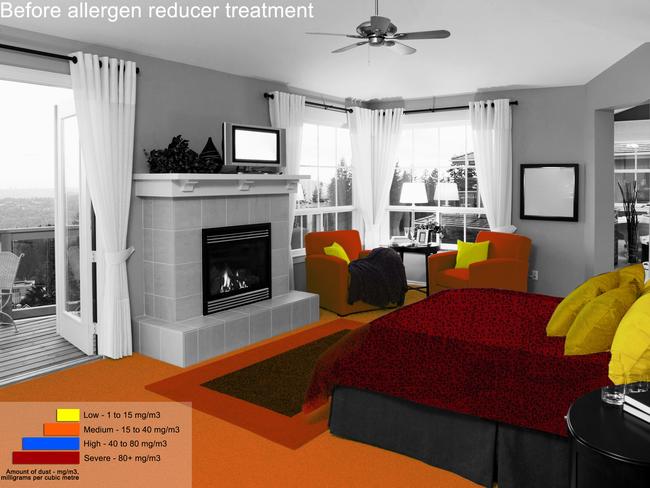Allergen hotspots in your home: Cleaning tips for asthmatics and people with allergies
WHERE DO you think the allergen breeding grounds in your home are? In your carpet? Your pet basket? Guess again.

WHERE DO you think the allergen breeding grounds in your home are? In your carpet? Your pet basket? Guess again ...
It might not be the first thing that comes to mind, but your doona is actually the worst allergen offender — by a mile.
Doonas release up to seven times more dust than sofas, chairs, carpets and rugs, and dust found on doonas also contains on average bigger dust particles, which dust mite allergens are known to live off in the home.
“As we sleep with doonas close to our breathing zone, exposure to allergens within doonas tends to be greater than exposure to allergens on any other items in the home and can be a potential risk,” Wayne Anderson, air quality expert at BELL Laboratories, told news.com.au.
BELL analysed dust burden and allergens from seven different surface types in seven homes in Sydney and Melbourne, to find out in-home allergen hotspots.
While the doona was found to be the worst offender, it’s not just because we spend a third of our lives snuggling under it.
“Doonas contain beyond-severe levels of dust in each home (over 100mg/m3) — a major carrier and source of airborne allergens,” says Mr Anderson.
“Items containing feathers or down such as doonas and down-filled furniture released the highest concentrations of dust, followed by woollen items such as rugs or items upholstered with wool fabrics.”
By way of comparison, cat and dog allergens, which are common in the home, were detected at 0.05mg/m3 and 0.14mg/m3 respectively. Cushions and stools release fifteen to twenty times less dust than doonas.

Australia has among the highest prevalence of allergic disorders in the developed world — around 20 per cent of Australians suffer from allergies — which accounts for an estimated half a million sick days in each year.
Allergens provoke allergies which make you sneeze, wheeze and itch, and are particularly problematic if you are asthmatic. The prevalence of allergic rhinitis and eczema in Australia has almost doubled in the past 15 years.
“Too small to be seen with the naked eye, allergens are hidden substances or organisms which lurk inside the home either from dust, pollen from the garden, pollution in the air or even hair from house pets,” explains Anderson.
“Allergens may be invisible but they are everywhere and disseminated as dust particles which then accumulate on our household furnishings.”
So get out the vacuum and start washing your linen more often — with regular cleaning and incorporating the use specific allergen-reducing products, allergens can be managed.

Mr Anderson highlights the top three allergens to watch out for inside your home, based on BELL Laboratories’ findings:
1. Dust mites
House dust mites are eight-legged microscopic creatures that are closely related to spiders and ticks. Designed to live with humans, these tiny spider relatives live in house dust where they feed on human skin scales. Humans shed approximately 5 grams per week of dead skin cells, which is enough to feed many thousands of mites. Dust mites produce faecal matter (droppings), at an average rate of 20 per day. Dust mite droppings (rather than the dust mites themselves) are the most prevalent form of house dust allergen.
Preferring warm, humid conditions, large populations of mites are found in beds, pillows, carpets, soft furnishings and soft toys. Although eradication of these natural inhabitants of your home is virtually impossible (females lay 20 to 50 eggs every three weeks), you can take practical and effective steps to reduce exposure to airborne dust mite allergens in your home by cleaning regularly.
2. Pet dander
While pets are cherished members of many households, dander (skin flakes) from these animals is a significant allergy trigger for many people. All warm-blooded household pets, regardless of hair length, produce allergenic proteins which can be efficiently dispersed into the environment as they shed hair, dander and fluids. Dead skin cells in their dander can serve as a food supply for dust mites.
Indoors, the allergens accumulate on household furnishings including carpets, upholstery, mattresses, curtains and other textiles. They can sometimes linger in carpets and bedding for years if not dealt with and their presence is a concern for many people, particularly sensitive individuals, who experience allergies such as asthma and allergic rhinitis (hayfever).

3. Pollen
Pollen from grasses, weeds or trees can trigger symptoms of allergic rhinitis (hay fever) and asthma. It can blow into your home from outdoors during the pollen season which typically occurs between late September and Christmas. Pollen can be distributed widely throughout the home and will adhere to clothes as well as bedding and towels if hung to dry outside, so if this is a problem for you, use a clothes drier or hang your washing out in an area which is more removed from grasses and trees.
This article is based on findings from BELL Laboratories and Ambi Pur research, which quantified the number of allergens and dust particles found in homes in Australia to determine in-home allergen hotspots.



